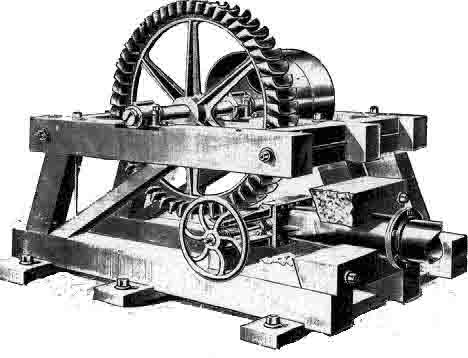
|
Newsletter The Samuel Knight Chapter The Society for Industrial Archeology Issue Number 15 August 1, 2003 |

|
Newsletter The Samuel Knight Chapter The Society for Industrial Archeology Issue Number 15 August 1, 2003 |
Copyright © 2003 Samuel
Knight Chapter of the Society for Industrial Archeology.
The Newsletter is
published in December, April and August, with special issues when they are
needed.
The Chapter web site is
hosted by the SIA headquarters site:
http://www.sia-web.org/chapters/knight/knight.html
While details are still to be worked out, mark your calendars now for Saturday, 25 October 2003 for the Chapter’s annual meeting, which will be held in conjunction with a tour of the former SP Shops adjacent to the California State Railroad Museum (CSRM) in Sacramento, CA.
Probably all of our members have visited the Museum, arguably one of the finest railroad museums in the world. Far fewer have had the opportunity for a visit to what was once the largest industrial complex west of the Mississippi, the Sacramento Shops of the Southern Pacific Railroad. Thanks to the staff of CSRM, we have organized a tour of the Shops in conjunction with our (hopefully brief) meeting.
Quoting from a brochure produced by the Museum:
The complex began to emerge as the Central Pacific Railroad Shops in 1867… the Sacramento Shops became SP’s general shops for the next century and a quarter. The shops were gradually enlarged until they became the largest railroad shops, and, in fact the largest metal and woodworking plant west of St. Louis. The shops, covering almost 200 acres, made the Southern Pacific system nearly self-sufficient, building and maintaining everything from locomotives and rolling stock to office and station furniture. For 80 years, the shops were the largest employer in California’s Central Valley, and for a time the largest industrial complex in the West.
The Museum recently dedicated a new transfer table between the boiler shop and the erecting shop. The shops house the Museum’s restoration effort where railroad restoration specialists breathe new life into historic locomotives and rolling stock.
Details of the tour will be sent out to the membership
approximately one month prior to the scheduled date of 25 October. JM
As of 1 August 2003, the Chapter had 57 current year members, and an additional 28 members who had paid dues in recent years but not in 2003. The checking account balance as of 1 August is $1,892.43. The only pending obligations are the costs of this newsletter, approximately $160, and of Issue #16 in December, and the monthly bank service charge of $7.50. There may be some expenses associated with the annual meeting in October.
The effort to scale back the mailing lists has reduced the costs of the newsletters by approximately 50%. The use of email also reduces Chapter expenditures. If you are not receiving Chapter-related email and wish to, drop an email to Jay McCauley.
The Chapter web site, hosted by the SIA National Office, has been updated to include prior newsletters. This issue should be on the web site shortly after its hardcopy publication. Newsletters even in PDF™ form are too large for convenient email to the membership.
We’re always on the look out for
relevant activities. Drop Jay or Tony a
line if you have ideas, especially if you’d be willing to set something
up. JM
by Noel Kirschenbaum and Jay McCauley
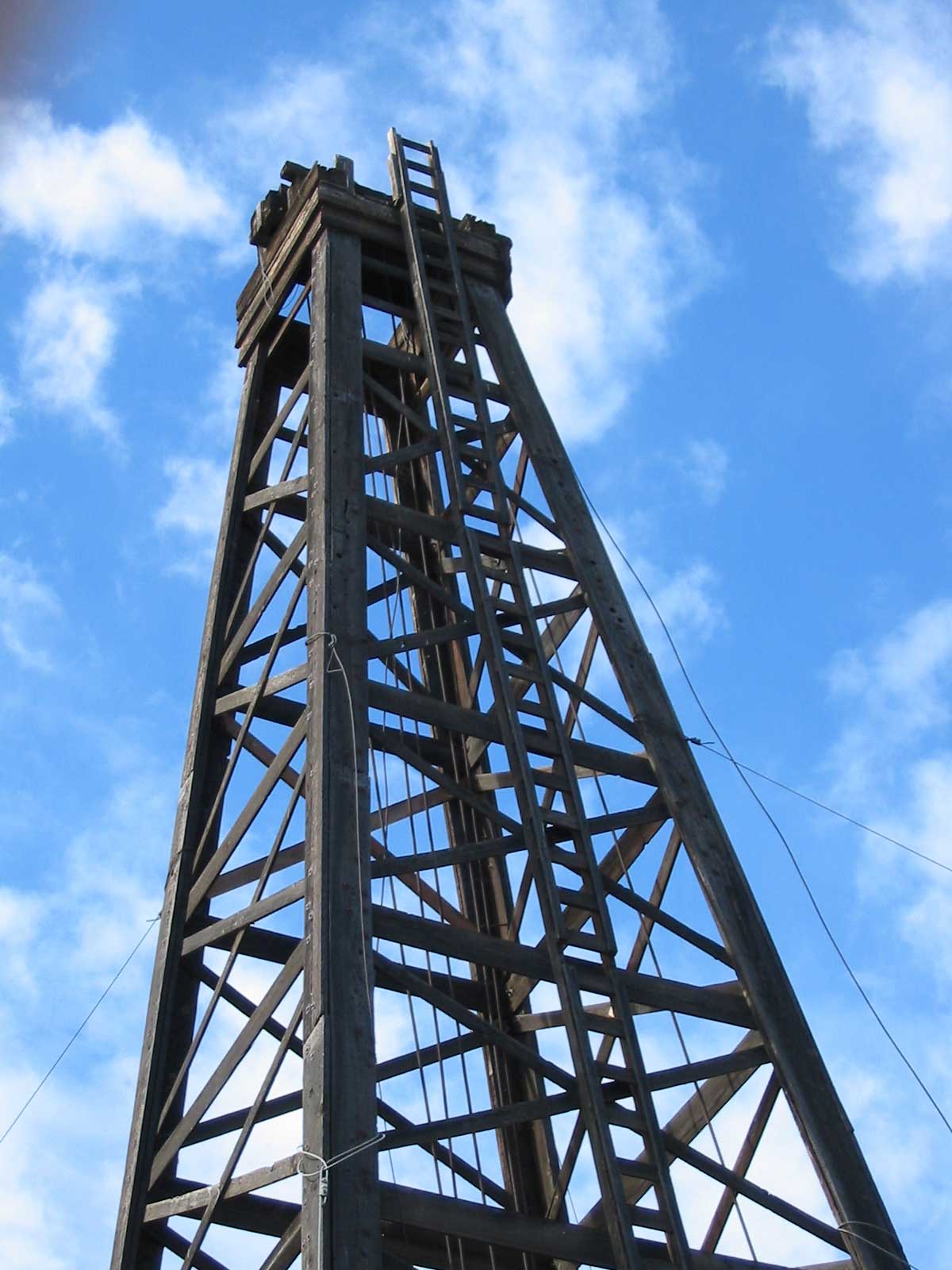
Derrick at the Kern County Museum
Our Kern County adventure started on Saturday May 3 with a visit to the new Black Gold exhibit at the Kern County Museum. Black Gold is a “museum within a museum” covering all aspects of the oil industry from the geology to production and distribution of end products. The $4 million Black Gold exhibit opened on 23 Nov 2002. The Kern County Museum is operated by the County Superintendent of Schools, so Black Gold has a strong educational component. There are many opportunities for hands-on experiences. They were still working some of the bugs out of the new exhibits, but overall this was a very impressive addition to the Museum. Although we spent over an hour at Black Gold, most of us could have spent even more time there. The rest of the open-air part of the Museum highlights historic oil field equipment. It was a struggle to round up the members to continue on to the next stage of the adventure; there were so many interesting artifacts and structures to explore!
The remainder of the day we were led on a geological field trip of the Kern County portion of the San Joaquin Valley by Dr. Gregg Wilkerson of the Bureau of Land Management. His lively commentary and deep knowledge made the trip a fascinating one.
We began the geological tour at the site on the outskirts of Bakersfield where oil was discovered in 1899. The oil-bearing sands can be seen outcropping on very shallow road cuts. This field is not only still in production, but it has enormous reserves still remaining.
The Kern River Field is notable for several reasons:
· It has a very thick zone of “pay sands” – hundreds of feet in thickness
· Its oil is heavy (i.e., viscous, or “thick”), so that efficient recovery is achieved by steam flooding, wherein large quantities of fuel (now mainly gas or coal) are combusted, generating steam which is then injected deep into the oil-bearing sands making the oil hot and fluid enough to be pumped out of the ground
· It was second in production in California in 2001, exceeded only by the Midway-Sunset field, also in Kern County and which we visited. At year-end 2001, it ranked third in cumulative production in the state, at just over 1.8 billion barrels of oil – exceeded by the Midway-Sunset and Wilmington fields.
· It had 8,784 producing wells in 2001, second only to Midway-Sunset which had 11,202.
· Despite its large past production, at year-end 2001 Kern River was ranked as having the third largest reserves in the state, following Midway-Sunset and South Belridge.
· By 1903, this field enabled California to be the largest producer in the U.S.
West of McKittrick (near Reward) we saw a mineshaft (covered, but enabling the old timber bracing to be viewed) used in the latter part of the 1800’s for recovering oil found at shallow depths. (See picture at http://www.sjgs.com/mckittrick.html.) Dr. Wilkerson told us men descended a ladder to the working level; as no flames could be used, one worker would hold a large mirror to reflect sunlight down the shaft. The men would work without clothes, presumably taking a bath in kerosene afterwards. We saw shallow brea pits with dead birds, trapped when they were caught in the viscous oil, and we saw oil seeps where oil was slowly dripping out of the formation which was cut by a shallow, intermittent stream. See also http://www.sjgs.com/tarpits_hist.html.
Nearby we saw a large open pit that had been mined in the 1970’s or 1980’s by Getty (later acquired by Texaco) in conjunction with two pilot process plants to evaluate the feasibility of mining oil-bearing material; one plant recovered oil by thermal means, the other used a solvent to extract the hydrocarbons. Neither plant remains.
Until a few years ago, steam for steam flooding was simply generated in conventional boilers. A new technology, co-generation, was introduced into oil field steam generation in the 1980’s. Co-generation generates electricity and uses the excess heat to raise steam, making the overall process vastly more efficient than separate electricity and steam generation.
On Saturday afternoon we visited the Midway-Sunset Co-generation
plant (http://www.edison.com/corporate/company_proj.asp?bu=eme&id=1597
Alas, a broken link, 10/06 Jay)
at Fellows, CA where we were hosted by Teri Humphrey. This 225 MW plant opened in 1989. It is jointly owned by Edison Mission Energy (part of Edison
International, which also owns Southern California Edison, SCE) and Aera Energy
LLC (jointly owned by Shell and ExxonMobil), who operates the surrounding Midway-Sunset
oilfield. About 1/2 of the electricity produced, 112 MW, is sold under a long
term contract with Edison. The
operation of the oilfield consumes about 20 MW. The remaining electricity is
sold under other long term contracts or through the California Independent
System Operator (CalISO) to the overall California electricity market.
Midway-Sunset is powered by three natural gas turbines, jet engines that run on natural gas. The turbines power generators that produce the electricity. The exhaust gas from the turbines is still about 1000˚ F and is then used to raise steam for the oilfield’s steam injection system. The gasses are approximately 300˚ F when they exit the steam generator.
After a terrific mid-afternoon snack and a video explaining co-generation, we got a tour of the control room. The plant is in the process of upgrading their control system, so both the old and new systems were available. The new system is much more graphic, making it easier for the operator to monitor the plant. The main graphics show the plant schematically with sensor readings displayed on the graphic, e.g. the inlet air temperature is displayed at the turbine inlet. The new system uses flat panel displays that had the computer types in the tour drooling. Everything is automated, so the entire plant is operated by two operators and a maintenance person.
The plant operates essentially continuously, coming down for maintenance or upgrades about once a year. On our way out, we roamed around a little bit. It was fascinating to be standing in the middle of all the machinery with 230 KV crackling overhead!
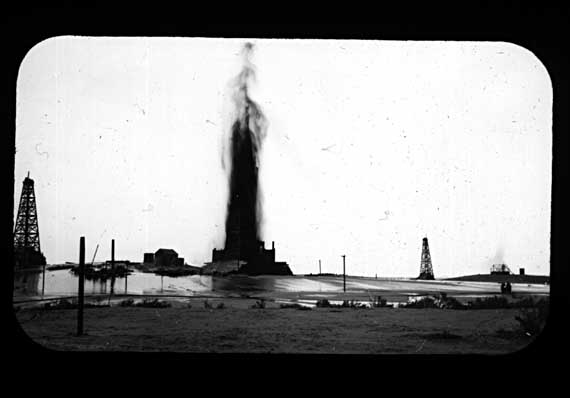
Lakeview Gusher (from http://geoimages.berkeley.edu/GeoImages/LanternSlides/GreatValley/NC-G-124.html)
The tour continued on to the site of the Lakeview Gusher. The Lakeview No. 1 gusher wasn’t the first in California, but it was the largest. It flowed, uncapped and untamed, at 18,000 bbls. per day for 18 months in 1910 and 1911. When it blew, in March, 1910, its initial flow was estimated at 125,000 bbls. per day. The gusher of oil and sand was 200 feet high. The flow continued unabated, and thirty days after the well first blew in, the flow was estimated at 90,000 barrels a day. Crude prices were brought down to 30 cents per barrel. The well caved in September 10, 1911. Although Lakeview No. 1 produced 9.4 million barrels during the 544 days it flowed, less than half of this oil was saved-the rest evaporating off or seeping into the ground. Even after the old hole was cleaned and new casing installed, Lakeview No. 1 never again flowed more than 30 barrels a day and was finally abandoned.
We paused briefly at an overlook near the Elk Hills Naval Petroleum Reserve. The Teapot Dome scandal during the administration of President Harding in the 1920s involved oil from the Reserve. Dr. Wilkerson wove an engaging tale of geology, greed, corruption and oil in relating the details of the scandal and how it was tied to this place.
We all got together Saturday night for dinner at Benji’s French Basque Restaurant. A lively evening of discussion and laughter ensued.
Sunday started early with a trip to the San Joaquin Refining Company (http://www.sjr.com). They are a specialty refining company producing a variety of products such as oil used in printing and “CARB Diesel” (a very low sulfur diesel fuel for use in engines mandated by the California Air Resources Board to have very low emissions). We were guided by the company president, Majid Mojibi, who enlivened the tour with insights into the larger picture of operating a refinery in the current economic and regulatory context.
The adventure wrapped up with a visit to the West Kern Oil Museum in Taft, CA (http://www.westkern-oilmuseum.org) on Sunday. This Museum specializes in the local oil business. They had a room dedicated to the major firms in the immediate area with brief corporate histories, images etc. The Museum had a number of photographs of some of the sites we visited the day before. This helped tie together the trip. Of particular interest were photos of the Lakeview Gusher, with the surrounding lake of oil. Little remains at the actual site. It must have been an incredible sight to see.
From an IA perspective, the most significant thing at the Museum was the tearing down of the last surviving wooden oil derrick, Jamison #17, in Kern County. Photographs from the early years of these fields show a virtual forest of these derricks. Although used primarily in the drilling of the well, they were left in place to allow for maintenance and other activities. Jamison #17 was drilled in 1917 and was still producing into the 1980’s. Newer technology replaced all these derricks long ago, leaving only the Museum’s. Unfortunately, the ravages of time took their toll on the structure and it had become dangerously weakened. The rig was pulled down only days before our visit. Plans are in the works to rebuild a replica. This is a reminder that industrial structures are ephemeral, even if they have been lovingly preserved.
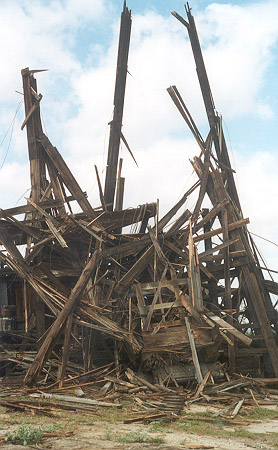
Remains of Jamison #17 (from the Museum's web site)
It was a fantastic weekend.
Special thanks to Tony Meadow for organizing everything, and to all the
folks we met along the way. NK & JM
by Scott See
This year’s annual SIA conference was held from May 29th to June 2nd in Montreal, Quebec. As usual, the conference schedule included pre-conference tours, a day of paper sessions and Society business meetings, a Saturday evening banquet and post-conference tours. Our chapter was well represented this year as Noel Kirshenbaum, Jay and Sharon McCauley and Scott See were able to attend.
One of the most popular tours on Thursday afternoon was a boat tour of the Lachine Canal. The canal was in operation from 1825 to 1970 when it was closed to navigation and essentially abandoned. The focus of a huge revitalization project since 1997, the canal is now a National Historic Site administered by Parks Canada and was reopened to pleasure boating in May 2002.
Our tour began at Atwater Market, traveled downstream through the St. Gabriel Lock, reversed direction at the Peel Boat Basin, stopped at Point des Seigneurs Archeological Park before reentering the St. Gabriel Lock and returning to our starting point. Along the way, an interpreter from Parks Canada provided a historical description of the canal and answered our many questions. Originally constructed to ease navigation around the Lachine Rapids on the St. Lawrence River, it also became an important industrial center as various industries made use of its hydraulic resources. Although it was neglected for almost 30 years, the area is once again bustling as developers take advantage of the many opportunities to convert industrial buildings to residences and shops, historians and archeologists study the rich shipping and industrial legacy, and visitors and the citizens of Montreal take advantage of the many recreational opportunities now offered by the canal.
On Friday there were many tours offered to appeal to a wide variety of interests. There were tours of hydroelectric sites, cider and beer producers, a diesel engine manufacturer, a General Electric hydropower turbine factory, a Johnson and Johnson facility that produced sanity pads and many more. The tour I signed up for was titled “Planes, Trains and Turbines”. Due to some last minute changes, however, we ended up touring a hydroelectric plant, an early 19th century grist mill (Moulin Fleming), a corrugated cardboard box manufacturer and the GE Hydro plant that was originally on the schedule.
Of these facilities, the GE Hydro plant provided the most impressive display of industrial manufacturing. Each of the turbines is custom made for a specific application. The factory receives rough castings as a start to their work. The turbines are then constructed and assembled using huge metal machining equipment and then meticulously finished by small crews of workers using welders and grinders. In addition to touring the manufacturing facility, we were also able to view the extensive design and testing laboratory where GE turns their customer’s specifications into prototypes for testing. It was an impressive building with what seemed like miles of pipes, gauges and valves all used to simulate various water flow conditions.
Saturday brought the traditional series of academic paper sessions and a luncheon where the society conducted various business matters and presented several awards. During the day I attended a presentation that explored the revitalization efforts along the Lachine Canal, another which demonstrated links between the salt and lumber industries during the 19th century in Saginaw, Michigan (my hometown) and a final paper presented by Fred Quivik that explored the history and operation of the Standard Mill at Bodie, California.
On Saturday night the attendees were treated to a banquet at the Canadian Railway Museum. The museum’s collection had recently been moved into an impressive new facility where they are able to display more than 40 pieces of equipment on 12 indoor tracks. In addition to excellent food served in a “roving banquet” style, a number of docents were available to provide insights into the history of the various engines and railcars that were on display. Finally, an electric trolley provided rides on a small stretch of track around the building to those willing to brave the cool, misty evening. It was a fantastic way to end a truly informative and interesting trip.
The organizing committee did an excellent job providing a glimpse in the industrial history of Montreal. If you’ve never attended an annual SIA conference, I would highly recommend it. Next year’s conference is scheduled for June 10th – 13th in Providence, Rhode Island. Watch the SIA website (http://www.social.mtu.edu/IA/sia.html) for additional information as it becomes available.
by Jay McCauley
On Sunday, 20 July 2003, several Chapter members and friends participated in a nautical tour of sites around San Francisco Bay that are significant to the labor movement. The tour was part of LaborFest, an annual month-long celebration of labor, which includes a wide variety of events.
The tour began by boarding at the newly restored Ferry Building. This magnificent restoration will have a formal grand opening in the Fall of 2003. A few businesses are already in operation. It is a delight to stroll through the grand concourse filled with light from the clearstory windows. The Ferry Building was the hub of activity in the years before the great bridges were built. It had fallen on hard times, and had been partitioned into a warren of small offices. In a bold step for adaptive reuse, the building’s interior was completely replaced, but the elegant exterior was retained, including the clock tower that is a San Francisco landmark.
A quick dash across the Bay brought us to Richmond. The city was the terminus of a Santa Fe Railroad line from Stockton that broke the stranglehold on Bay traffic held by Southern Pacific. The city rapidly developed a number of industries including oil, chemicals and manufacturing. The waterfront was the site of the Kaiser Shipyards, created in great haste to build Liberty Ships during WWII. The shipyards and other wartime plants such as the Ford military vehicle plant had an insatiable demand for labor. This demand forced unions and employers to relax long-standing barriers that kept persons of color, women and others out of the industrial workforce. Many of the foundations for the later civil rights movement and labor’s participation in it can be traced back to the entry of these new classes of people into industrial work.
The tour passed by the Red Oak Victory and the Rosie the Riveter Memorial, sites of a 2001 Chapter excursion. As mentioned in a prior Newsletter article on the Jeremiah O’Brien, Rosie didn’t do any riveting on Liberty or Victory ships, as they are welded. Maybe Wanda the Welder would be more appropriate?
Another dash across the Bay took us to the site of the construction of the new Bay Bridge. There, Mike Munoz, a “pilebutt” (person who operates a pile driver) spoke enthusiastically about the work his union, UBC 34, was doing for the new bridge, and how the union had lead the fight for worker safety in this highly dangerous job of bridge building.
On to the Port of Oakland and the massive container ship terminal, where Harvey Schwartz, an ILWU historian, spoke about the enormous changes container ships have caused in the labor movement. LaborFest celebrates the 1934 General Strike that was triggered by the abuses suffered by the hoards of longshoremen needed to load and unload ships. Now, a handful of ILWU members perform the aerial ballet of unloading the huge container ships.
One last dash across the Bay took us to the San Francisco side where we passed along the waterfront where many former heavy industry sites are now abandoned. There are some interesting structures at the former Union Iron Works, a shipyard, that might be a potential Chapter visit.
After returning to the Ferry Building, several of us strolled down the Embarcadero and enjoyed the public art and plaques discussing the area’s history and role in the labor movement.
The trip was quite thought provoking, and sparked some lively
discussion on the way home. Thanks to
the folks at LaborFest for an informative and fascinating trip! JM
by Ed Wishart
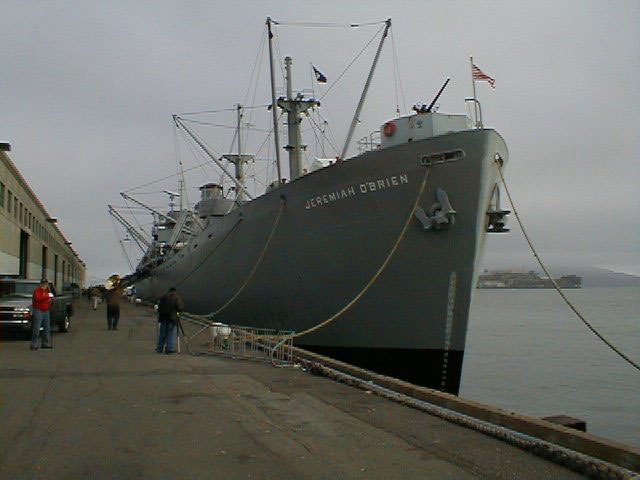
S.S. Jeremiah O'Brien docked at Pier 45 in San Francisco
I had visited the Jeremiah O'Brien over the years as it moved from one pier to
another along the San Francisco waterfront. What an ugly, lovely piece of
maritime and WWII history. Advertised were occasional trips that
intrigued me, but I never did anything about it. Then an E-mail from Jay
McCauley alerted us to the Stockton trip on 3 July and I decided to experience
steaming on the Sacramento delta in a piece of industrial archeology. Jay wrote
an in-depth article about the trip to Sacramento last August in the chapter
newsletter #13:
http://www.sia-web.org/chapters/knight/newsletters/Issue_13.htm
that gives some background of the Liberty ship program.
We departed pier 45 (Fisherman's Wharf) shortly after 9:00
with 2 tugs pulling us from the pier. There was a crew of approximately
100, 350 passengers as well as the Gas House band and the caterers that
prepared lunch and a great barbecue dinner in the afternoon.
The main attraction for me was the steam plant, for there are few places left
in the world where one can observe reciprocating steam machinery in its native
environment doing real work. It is even better than that: in a non-OSHA
environment where one can mingle with the crew and smell, hear and feel the
primitive power of the engine as it turns a 13" diameter shaft propelling
us across the Bay.
The deck winches and anchor windless all operate on steam, as does the steering
engine in the fantail. All this deck machinery is plumbed with inlet and
exhaust steam back to one of 2 condensers --recall that boiler water is a
precious commodity at sea. The major loss of boiler water on our trip was
whistle blowing by the ship's master, Captain Patrick Moloney, as he made our
presence known across the bay and up the San Joaquin River. These winches
are used bring supplies on and off the ship as well as raise and lower the 2
gangplanks. It pleased me to see a woman crew member operating a winch.
The main engine of 2,500 HP, built by Hamilton Engineering in Hamilton Ohio, is a 270,000 pound unit 19 feet tall and 21 feet long. Obsolete in the 1920s by the then standards, it still is very sophisticated to the novice. For example, the cross head, forward slipper guides are water cooled, adding more plumbing to an already crowded space. Triple expansion, with 24.5, 37 and 70 inch bores and a 48 inch stroke, it takes steam from 2 water tube boilers at 200-220 psi and 450˚ temp. Bunker C oil at 125˚ and 200 psi is fed to 4 burners in each boiler. The ship burns about 300 gallons per hour. Thus, an approximate 30 gallon/mile economy. The lack of sophistication allowed this engine to be made by many suppliers while the Navy was using more complex turbines for the warships being built and there was not the capacity to supply both programs at the start of the war.
Being able to stand next to such a huge engine and watch an oiler reach in and feel a 14 inch diameter connecting rod journal for over-heating as it passes by at 12 feet per second is a sight I will remember for some time.
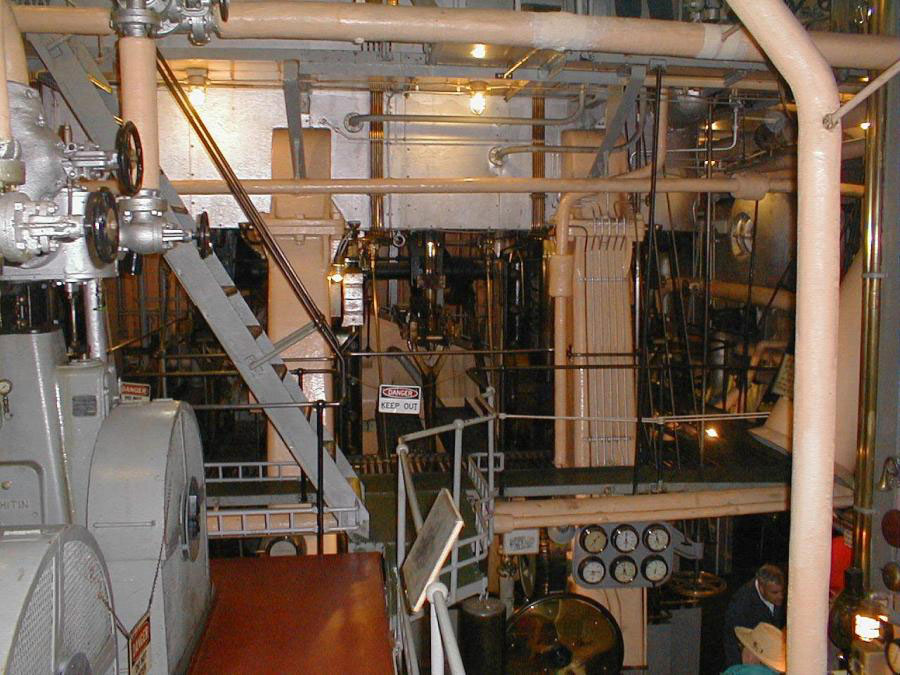
Engine Room of the O'Brien
Besides the joy of the steam machinery, a second and as
intense joy was the crew and passengers.
The crew were there for the love of their ship. Eager to answer
questions and show off parts of the ship not regularly open to visitors they
added a dimension that one could not experience on almost any other large
vessel. The machine shop in the `tween decks' of hatch 5 was one of these
places. This well equipped shop has several lathes, a milling machine and
a welding area. A 60 year old ship in a marine environment needs constant
upkeep and repair and this shops plays a vital role in that endeavor. The
passengers were of similar age as the crew,
elderly, but there mostly for the experience being on something old and/or
historical. Many had experiences that included WWII events or they were
involved in other areas of historical interest: antique planes, trains, logging, etc, so it was easy to find
people to talk to with interests similar to my own.
The trip up the delta was hot so most of us were seeking shade when on
deck. We arrived at Rough and Ready Island approximately at 6:30. This is
a huge naval terminal that has recently been transferred to the Port of
Stockton. Buses met us for a return trip to San Francisco or to other
points in the area for those who were staying over for the return trip on 7
July. I was told that a chart showed a voyage of 88 miles, so the 9 hours
en-route was at about 8 knots.
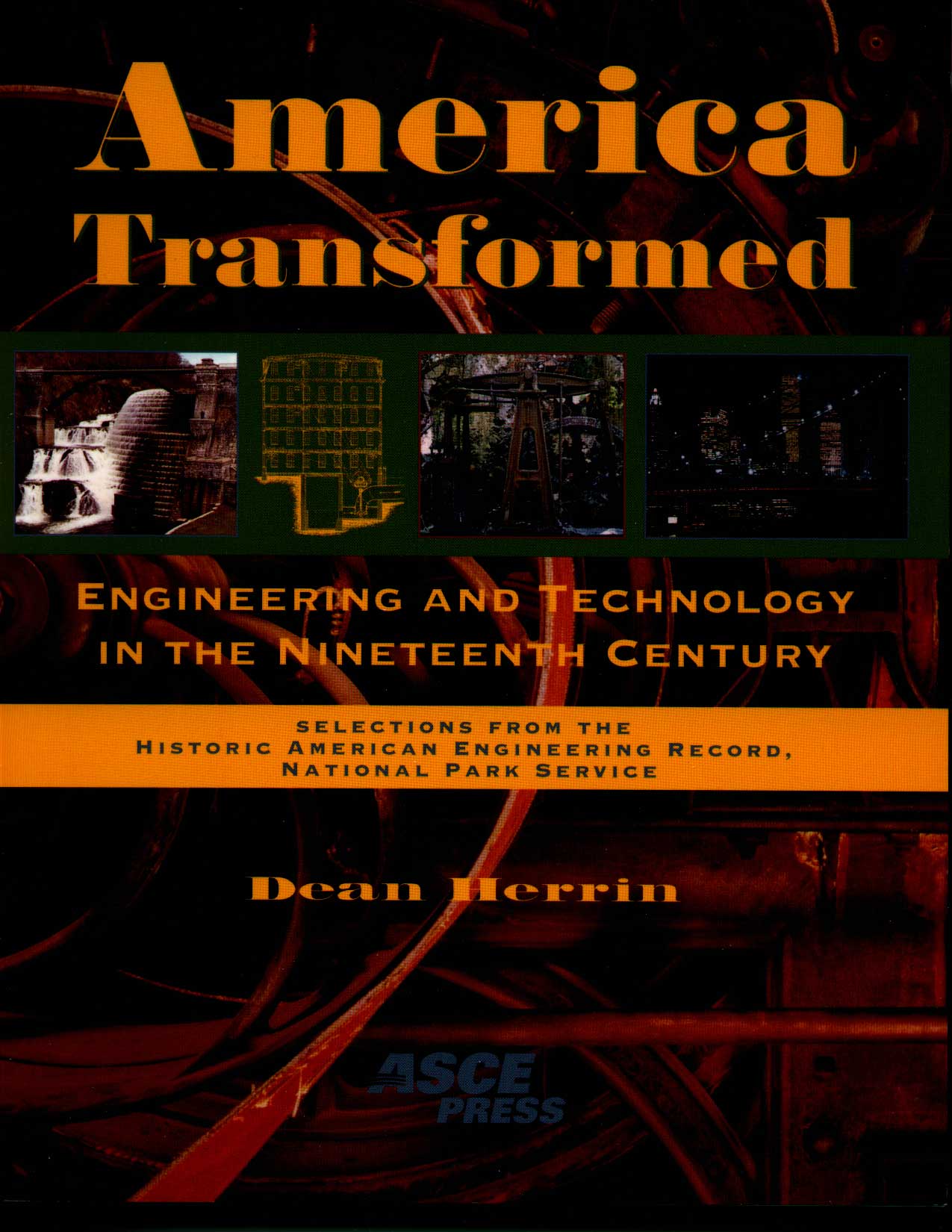
IA had a brief review of this book by Dean Herrin, published by the ASCE Press. It is a selection of drawings and photographs from the Historic American Engineering Record of the National Park Service. If you’ve never seen HAER documentation, prepare to be completely blown away. The meticulously prepared drawings and photographs are beautiful and moving. They give the reader a glimpse into the details of significant engineering sites, and convey immense amounts of information. Herrin’s commentary places the selections in context and provides an organizational framework for the material. The four main sections are titled:
· A Wealth of Materials
· Making Things
· Structures and Materials
· Going Places
Page 52 contains photographs of the Troy Gasholder House in Troy, NY. Eric Delony’s drawing of this building is part of the SIA Logo.
The book may be ordered from the ASCE, here’s a URL: http://www.pubs.asce.org/BOOKdisplay.cgi?9991546
by Robert W. Piwarzyk
© 2003 Robert W. Piwarzyk
Originally published in the International Brick
Collectors Association Journal, used with permission.
(This is the second in a series of articles by “Brick Bat
Bob” Piwarzyk about Holyoke, MA and the industries there.)
I grew up knowing my home town as the “Paper City,” but before that it was known as the “Brick City.” All of its mills and tenements for the workers were constructed out of bricks. I grew up on the top floor of a five story apartment house made of yellow brick with red brick patterns, went to red brick and yellow brick schools, and went to a red brick church.
My maternal grandfather, John Konopacki, came from Poland. He was a brick layer, and later contracted to build brick homes. His two sons, Melvin and Leonard, learned the trade and worked with him. My father, William, hired on as a hod carrier and found that back-breaking work. Together they built my grandparents’ home, and also my Uncle Len’s home. Naturally, both were made of brick.
I got to help build my uncle’s house. My jobs were to straighten bent nails or clean mortar off the used brick. My uncle tells me he bought these for $280.00 for 22,000 undelivered. Maybe they gave me this work to keep me out of harms way? I learned to chip off hardened mortar with a trowel as well. That was back in the 40s and after the homes were built I didn’t even think of bricks for another 35 years.
My sisters, cousins and I knew which houses, walls, and steps our relatives built and someone would always be sure to point out one when the family drove by. We knew it was good work and were proud of them. When the freeway came through, everyone was sad because some of their best work was torn down. But I was particularly proud of the one I helped build which my uncle and Aunt Wanda still live in.
Recently I was doing some research on my home town and its origins. When mention was made that the Lynch Brick Company made the brick that built the city, I checked “Brick Brands of the United States,” compiled by Jim Graves of the International Brick Collectors Association, and there it was! LYNCH in raised letters in a frog. Made by Lynch Brothers in Holyoke, MA. Then I contacted my Uncle Len, now 82 years old. He did not know the location of the first yard, which was located right where the city is now. But he did go to their yard across the Connecticut River in South Hadley Falls to pick up bricks for their jobs. My uncle loves facts and history, has always been very curious, observant and questioning; and is very sharp. I’ll let him tell you about his bricking experiences.
His grandfather, John Konopacki, immigrated to this country from Poland. According to my uncle, “He arrived knowing how to write his name and how to do his trade. When he left he was a Class 1 mason. In Poland they had two classes of bricklayer. Class 1 qualified to do outside finish-work and plastering, while Class 2 did back-up work for a lot less pay. Class 1 did both trades as many of their buildings were brick-faced and then cement-finished with all kinds of fancy cornices, facades and trim around the windows. It was an art as you had to make your own tool to pull certain types of molding and had to do all that fancy cement work. When the building was finished it was all cement in the front – no brick could be seen. He arrived a true craftsman.”
“Not speaking English was a big problem in that he could not understand what the foreman was telling him. He could get a job long enough to stir the mortar in the pan with his trowel. But when the foreman realized he wasn’t understanding, they usually paid him off right there. At least that gave him a little money for food. This went on until he got a break. A new high rise, the Wrigley, needed bricklayers badly. (This was probably in the Boston area.) He got a job, but when the foreman put him on a piece of work and told him what he wanted, he didn’t understand a word. While he did his fancy mixing he asked another worker, in Polish, to tell him about the work. The reply was, ‘Go see your Boss.’ Waiting to get fired again, the Boss returned, looked at him and said, ‘You didn’t understand a word I said, did you? I’ll lay this out dry for you so you’ll know what I want.’ Thus he learned that the bonds (the patterns) used in America were different than those used in Poland. So he checked some of the walls and started laying brick that way. The Boss was pleased and he worked to the end of that job, thirty or so stories up, gaining respect for his work.
“Back then bricklayers had to follow the work. He walked from city to city with his tools on his back, following the railroad tracks. First he went Sommerville, Lawrence and Worcester, Massachusetts; and then on to Michigan and Dayton, Ohio. The bad flood there created work, but after three years work got scarce so he came back east with his wife, Mary, and three children. Although his friends had told him there was lots of work in Holyoke, he could not find a job laying brick, so he hired on with a paper mill, Crocker-McElwin. He worked as a mason which included plastering huge vats used to bleach rags to make paper. These vats had to be lined with cement.”
(I remember when I was a kid, a horse-drawn wagon still came through our neighborhood once a week, with the ragman yelling, “Rags, buy yer rayyyaaagggzzz!” This was the only horse we city-kids saw, and I’d say now it was really an old bag-of-bones nag, but we loved to see it coming and the ragman would let us pat and feed it.)
The family moved way out to the country. John had purchased a few acres with a barn and planned to build his house there. Until it was done, he rented the upstairs in a nearby house where the owners lived downstairs. Although the house was to be a wood frame house, he built the foundation. There was a sand bank behind the barn and a little creek farther down the hill. Mother remembers pulling a wagon loaded with buckets of water up the hill from the creek with her brother Melvin. Her father needed the water to mix his cement. Leonard came along to “help” and Melvin was horsing around so much he caused the wagon to spill their water just as they neared the foundation. I think my mother, now 91, has yet to forgive him!
Leonard continued, “Using stones found at the site, he built his walls with rubble fill, and cement plastered the wall surface so the stones could not be seen. Chestnut trees on the land had been used for beams in the barn, and he used some in the house. Finishing that house around 1921, he began contracting to build homes. A license was not needed in those days.”
School was held in Holyoke at Kosciusko Hall, a Polish club named after the famous General Thaddeus Kosciusko who fought for our country’s independence. A teacher lived in the area who willingly taught the people to read and write English and helped them get their citizenship papers. She was a teacher that believed in helping people! Both John and Mary Konopacki became citizens in Holyoke, Hampden County, Massachusetts – John on June 30, 1925; and Mary on September 25, 1929.”
“They nearly lost it all in the 1929 Crash, but with a few cows and a lot of land were able to survive the bad times. Business got better and John got some good contracts to build a Polish Club, a big market, a soda factory, an auto dealership (Ford), a movie house, and a lot of homes (many of them were plastered).” His sons worked for him on many of these jobs.
The old house is still there as are his second and third homes, each one a little smaller as the family grew up and moved away, and as he and his wife aged. “The farm” is now a residential neighborhood in the middle of suburbia, a little over a mile from the center of town.